|
Helios
Authors: Martin Kallenborn & Matthias Prinz
Publisher: Hans im Glück
Year: 2014
review by

| x |
|
|
|
|
|
|
|
|
|
|
|
|
|
|
|
|
|
|
|
|
|
|
|
|
|
|
|
|
|
|
|
|
|
xxx |
|
|
|
|
|
|
|
|
|
|
|
|
|
|
|
|
|
|
|
|
|
|
|
|
|
|
|
|
|
 |
Helios, we may find out for ourselves what it is as the rules don't mention anything about it but instead start right away with explaining the game. That it must be something extraterrestrial is clear, in view of the creature with long pointed ears and a goatee staring at us from the cover of the box. He most probably is no follower of the Savior, for He has created man in His image. To subsequently transform yourself to a goat or at least try to look like one, must be logically considered as a serious case of blasphemy! The other people in the game, represented by thick card board cards, have clear extraterrestrial features too. It doesn't matter at all in the game, but at least the illustrator has lived his life to the full again on his favorite theme; a setting one must find appealing.
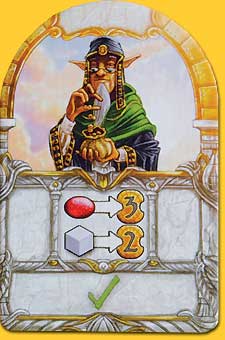
|
|
|
|
|
|
|
| x |
|
|
|
|
|
|
|
|
|
|
|
|
|
|
|
|
|
|
|
|
|
|
|
|
|
|
|
|
|
|
|
|
|
|
|
|
|
|
|
|
|
|
|
|
|
|
|
|
|
|
|
|
|
|
|
|
|
|
|
|
|
|
|
| Further, each player has one board, no two: a player board and a town board. Why isn’t the player board called planet board in the rules, what it actually is? Anyway, it is a strange planet, but who expected differently: it is flat, and the sun rotates rather jerky and close to the land. |
|
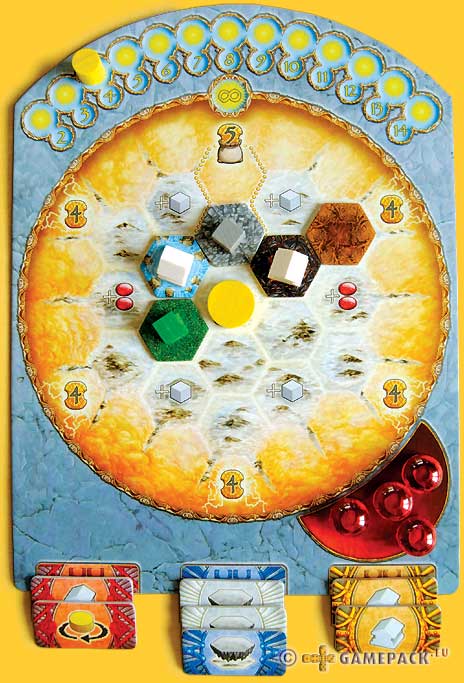 |
|
|
|
|
|
| x |
|
|
|
|
|
|
|
|
|
|
|
|
|
|
|
|
|
|
|
|
|
|
|
|
|
|
|
|
|
|
|
|
|
|
|
|
|
|
|
|
|
|
|
|
|
|
|
|
|
|
|
|
|
|
|
|
|
|
|
|
|
|
|
| On the town board we find all kinds of buildings in quasi isometric perspective, who, rather curious, can speed up the rotation of the sun, reduce the costs of building temples on the planet board, or enforce the direct income of manna. With this manna person cards can be bought, and because these are limited to eight and score possible additional points at the end of the game, these are quickly taken by the players after the first two rounds of the four rounds the game lasts. The cards bought still must be activated by paying the resources on it, only then it may be turned to its daylight side and can qualify for a direct bonus and/or score additional points for various conditions at game end. |
|
|
|
|
|
|
| x |
|
|
|
|
|
|
|
|
|
|
|
|
|
|
|
|
|
|
|
|
|
|
|
|
|
|
|
|
|
|
|
|
|
|
|
|
|
|
|
|
|
|
|
|
|
|
|
|
|
|
|
|
|
|
|
|
|
|
|
|
|
|
|
 |
|
|
| x |
|
|
|
|
|
|
|
|
|
|
|
|
|
|
|
|
|
|
|
|
|
|
|
|
|
|
|
|
|
|
|
|
|
|
|
|
|
|
|
|
|
|
|
|
|
|
|
|
|
|
|
|
|
|
|
|
|
|
|
|
|
|
|
| On the planet board various land tiles can be placed, one by one, but for this an action tile must be taken from a display of three columns of six tiles where each time only one of the the bottom three may be taken; in a round each player has four actions to do. He could for instance place a temple on one of the land tiles; this costs him resources that come from the land tiles. And these resource in return are placed on the land tiles when the sun shines, a third possible action where the sun may be rotated as many hexes as the sun-o-meter on the personal planet board indicates. |
|
|
|
|
|
|
| x |
|
|
|
|
|
|
|
|
|
|
|
|
|
|
|
|
|
|
|
|
|
|
|
|
|
|
|
|
|
|
|
|
|
|
|
|
|
|
|
|
|
|
|
|
|
|
|
|
|
|
|
|
|
|
|
|
|
|
|
|
|
|
|
 |
|
|
| x |
|
|
|
|
|
|
|
|
|
|
|
|
|
|
|
|
|
|
|
|
|
|
|
|
|
|
|
|
|
|
|
|
|
|
|
|
|
|
|
|
|
|
|
|
|
|
|
|
|
|
|
|
|
|
|
|
|
|
|
|
|
|
|
| Instead of a temple a player may build a house in the city and this way activate a building; this costs from one to three resources. Often the building has a direct advantage, sometimes at the end of the game. In any case the building itself scores points, but not much: from one to three points. |
|
|
|
|
|
|
| x |
|
|
|
|
|
|
|
|
|
|
|
|
|
|
|
|
|
|
|
|
|
|
|
|
|
|
|
|
|
|
|
|
|
|
|
|
|
|
|
|
|
|
|
|
|
|
|
|
|
|
|
|
|
|
|
|
|
|
|
|
|
|
|
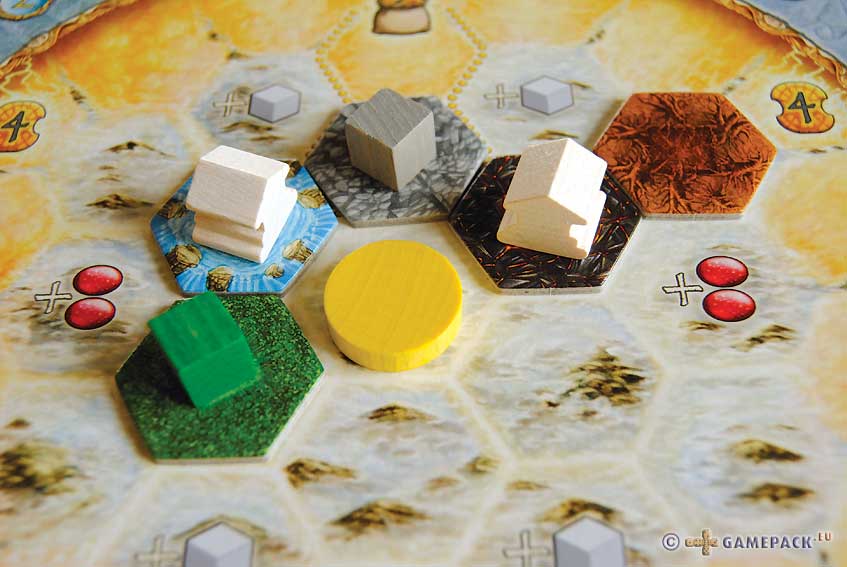 |
|
|
| x |
|
|
|
|
|
|
|
|
|
|
|
|
|
|
|
|
|
|
|
|
|
|
|
|
|
|
|
|
|
|
|
|
|
|
|
|
|
|
|
|
|
|
|
|
|
|
|
|
|
|
|
|
|
|
|
|
|
|
|
|
|
|
|
| There are direct earnings too, when the sun shines on a temple: points -curiously no manna- fall out of the sky because of the temple itself and for each adjacent land tiel to this temple; the points are put in a cloth bag and the accumulated total this way is unknown to other players. Also a resource cube of the matching colour is placed on each adjacent land tile that the sun is directly shining on. |
|
|
|
|
|
|
| x |
|
|
|
|
|
|
|
|
|
|
|
|
|
|
|
|
|
|
|
|
|
|
|
|
|
|
|
|
|
|
|
|
|
|
|
|
|
|
|
|
|
|
|
|
|
|
|
|
|
|
|
|
|
|
|
|
|
|
|
|
|
|
|
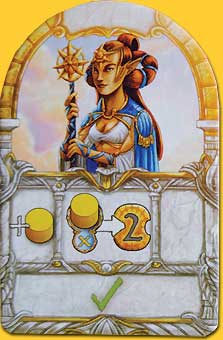 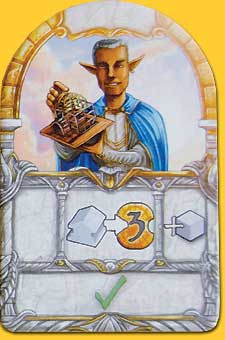 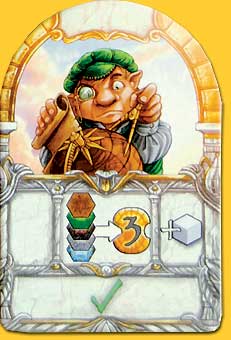 |
|
|
|
|
|
|
| x |
|
|
|
|
|
|
|
|
|
|
|
|
|
|
|
|
|
|
|
|
|
|
|
|
|
|
|
|
|
|
|
|
|
|
|
|
|
|
|
|
|
|
|
|
|
|
|
|
|
|
|
|
|
|
|
|
|
|
|
|
|
|
|
| The planet is, it has already been said but cannot be repeated often enough: flat, and as a consequence it is finite and has an edge. The constellation in this part of the universe however is this way, that at the edge five bumpers are mounted at regular distances, just as in a flipper game, and when a built land tile touches a bumper, the player receives the points indicated for it. |
|
|
|
|
|
|
| x |
|
|
|
|
|
|
|
|
|
|
|
|
|
|
|
|
|
|
|
|
|
|
|
|
|
|
|
|
|
|
|
|
|
|
|
|
|
|
|
|
|
|
|
|
|
|
|
|
|
|
|
|
|
|
|
|
|
|
|
|
|
|
|
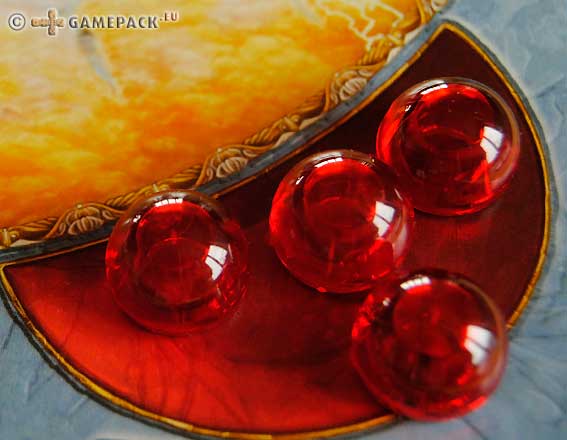 |
At other locations extra manna can be taken, or a resource of the player’s choice.
Eaxh chosen action tile is placed at the bottom of the player’s planet board, colour by colour, and four tiles of the same colour –or a combination with white joker tiles- qualifies for a bonus action of the player’s choice. In a game players usually take two or three of such bonus actions, but the focus lies in the first place on which action to take, and not on getting a bonus action. |
|
|
|
|
|
|
| x |
|
|
|
|
|
|
|
|
|
|
|
|
|
|
|
|
|
|
|
|
|
|
|
|
|
|
|
|
|
|
|
|
|
|
|
|
|
|
|
|
|
|
|
|
|
|
|
|
|
|
|
|
|
|
|
|
|
|
|
|
|
|
|
| Well, and then there are the details such as: only one resource may be placed on a land tile –with the exception of an activated warehouse on the town board-, a bonus tile does not have to match the colour of the tile it is placed on and may be placed on a tile already holding a resource, and some more of these small rules. The rules are not overly complex but to cover everything sixteen pages are needed and that's still quite a lot for an essentially simple game. |
|
|
|
|
|
|
| xx |
|
|
 |
At the end all categories are worked and the ponts for it disappear in the cloth bag, being a rather superfluous gimmick anyway. Then comes the big moment: all players empty their bags and count their points. This however is the biggest flaw of the game: that during the game there is no indication whatsoever of how any other player fares in comparison to his competitors; everyone is doing well but no player can compare his position with any other player. Hamper another player? Not possible! |
|
|
|
|
|
|
| x |
|
|
This makes the game a rather solitaire activity. Together with the total lack of atmosphere only the queak and squeak of the game system is audible and visible. We look directly at the carcass: a base motor being the planet board, some extra gas –the buildings-, some more afterburner –the presons-, and the completely superfluous bonus actions; it simply isn’t a solid unity, and as said total bleak.
Hans im Glück has published a series of fine games of high player quality during the last few years, but in this series Helios is a clear dissonant.
© 2014 Richard van Vugt
Helios, Martin Kallenborn & Matthias Prinz, Hans im Glück, 2014 – 2 to 4 players, 10 years and up, 45-60 minutes
|
|
|
|
|
|
|
  |
|
|
|
|
|
|
|
|
|
|
|
|
|
|
|
|
|
|
|
|
|
|
|
|
|
|
|
|
|
|
|
|
|
|
|
|
|
|
|
|
|
|
|
|
|
|
|
|
|
|
|
|
|
|
  |
|
|
|
|
|
|
|
|
|
|
|
|
|
|
|
|
|
|
|
|
|
|
|
|
|
|
|
|
|
|
|
|
|
|
|
|
|
|
|
|
|
|
|
|
|
|
|
|
|
|
|
|
|
|
  |
|
|
|
|
|
|
|
|
|
|
|
|
|
|
|
|
|
|
|
|
|
|
|
|
|
|
|
|
|
|
|
|
|
|
|
|
|
|
|
|
|
|
|
|
|
|
|
|
|
|
|
|
|
|
| x |
|
|
|
|
|
|
|
|
|
|
|
|
|
|
|
|
|
|
|
|
|
|
|
|
|
|
|
|
|
|
|
|
|
|
|
|
|
|
|
|
|
|
|
|
|
|
|
|
|
|
|
|
|
|
|
|
|
|
|
|
|
|
|
| x |
|
|
|
|
|
|
|
|
|
|
|
|
|
|
|
|
|
|
|
|
|
|
|
|
|
|
|
|
|
|
|
|
|
|
|
|
|
|
|
|
|
|
|
|
|
|
|
|
|
|
|
|
|
|
|
|
|
|
|
|
|
|
|
 |
|
|
|
|
|
|
|
|
|
|
|
|
|
|
|
|
|
|
|
|
|
|
|
|
|
|
|
|
|
|
|
|
|
|
|
|
|
|
|
|
|
|
|
|
|
|
|
|
|
|
|
|
|
|
 |
|
|
|
|
|
|
|
|
|
|
|
|
|
|
|
|
|
|
|
|
|
|
|
|
|
|
|
|
|
|
|
|
|
|
|
|
|
|
|
|
|
|
|
|
|
|
|
|
|
|
|
|
|
|
| x |
|
|
|
|
|
|
|
|
|
|
|
|
|
|
|
|
|
|
|
|
|
|
|
|
|
|
|
|
|
|
|
|
|
|
|
|
|
|
|
|
|
|
|
|
|
|
|
|
|
|
|
|
|
|
|
|
|
|
|
|
|
|
|
 |
|
|
|
|
|
|
|
|
|
|
|
|
|
|
|
|
|
|
|
|
|
|
|
|
|
|
|
|
|
|
|
|
|
|
|
|
|
|
|
|
|
|
|
|
 |
|
|
|
|
|
|
|
|
|
|
|
|
|
|
|
|
|
|
|
|
|
|
|
|
|
|
|
|
|
|
|
|
|
|
|
|
|
|
|
|
|
|
|
|
|
|